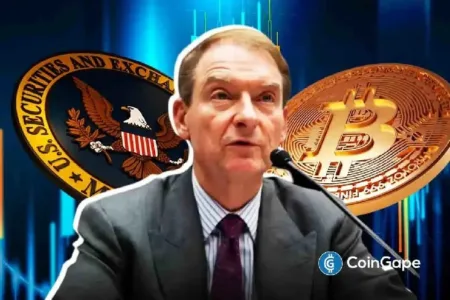The latest regulatory discussions in the United States regarding digital assets have gained traction, with Ripple CEO Brad Garlinghouse acknowledging the significance of the recent legislative focus on crypto clarity. His remarks follow a press conference by US digital asset policy chief David Sacks, who addressed lawmakers on evolving strategies concerning Bitcoin reserves and digital asset regulations. Garlinghouse noted that bipartisan engagement on crypto regulation represents a pivotal moment for the industry, reinforcing the need for legislative clarity.
Garlinghouse Responds to Crypto Policy Debate
Garlinghouse addressed criticism surrounding the discussions led by Sacks, emphasizing the long-term implications of bipartisan legislative engagement. In a statement on the X platform, he noted that the participation of key congressional committee leaders marks a fundamental shift in Washington’s approach to crypto regulation.
https://x.com/bgarlinghouse/status/1886984180657275133
He pointed out that the Chairs of the Senate Banking Committee, House Financial Services Committee, Senate Agriculture Committee, and House Agriculture Committee had aligned efforts to advance crypto legislation. Garlinghouse described this collective push as unprecedented and a critical moment in shaping the regulatory landscape.
His statement followed concerns from some industry observers regarding the policy direction outlined by Sacks. Market participants debated whether the emphasis on digital assets, rather than a Bitcoin-specific reserve, signaled a broader shift in regulatory focus. However, Garlinghouse’s remarks reflected a broader perspective, viewing the discussions as a step toward clarity in digital asset policies.
US Considers Bitcoin Strategic Reserve Amid Broader Crypto Discussion
David Sacks, who leads the US digital asset working group, addressed the Senate Banking Committee alongside key lawmakers, where he discussed the administration’s consideration of a Bitcoin Strategic Reserve. The initiative follows directives from President Donald Trump to explore national strategies involving digital assets. The discussion included evaluating Bitcoin’s potential role in national reserves and assessing the broader regulatory framework for digital assets.
Market reactions to Sacks’ comments varied. Some stakeholders viewed the discussions as progress, while others expressed concerns about the administration’s shift in focus from Bitcoin to a broader set of digital assets. The phrasing of Sacks’ remarks led to speculation regarding whether Bitcoin would be the primary focus of the proposed reserve or if other digital assets would be incorporated into the strategy.
Stablecoin Policies Take Center Stage in Legislative Efforts
Beyond Bitcoin reserves, Sacks also addressed the role of stablecoins in the evolving financial system. He indicated that stablecoins could support the US dollar’s global position by driving digital dollar adoption and increasing demand for US treasuries.
This perspective aligns with ongoing legislative efforts, including the Guiding and Establishing National Innovation for US Stablecoins (GENIUS) Act, introduced by Senator Bill Hagerty, as noted by Eleanor Terrett. Lawmakers continue to examine the implications of stablecoin policies as part of broader financial and digital asset regulatory discussions.
https://x.com/EleanorTerrett/status/1886790411705815194
The bill seeks to establish a clear regulatory framework for stablecoin issuers in the United States. The legislation proposes guidelines for licensing, reserve backing, and financial reporting requirements, aiming to enhance transparency and oversight while ensuring innovation is not stifled.
Stablecoin Issuers to Face New Regulatory Standards
The GENIUS Act formally defines stablecoins as digital assets pegged to the US dollar and mandates that issuers maintain reserves in US currency, Treasury bills, or other approved assets. Under the bill, issuers are categorized by asset size, with those holding over $10 billion subject to Federal Reserve regulations. Smaller issuers would remain under state-level regulatory frameworks.
The proposed legislation outlines requirements for stablecoin issuers to ensure financial stability and maintain the integrity of the digital asset market. Monthly audited reports on reserves would be mandatory to verify the backing of issued stablecoins. Issuers found to be misreporting reserves could face criminal penalties.
Oversight and Enforcement Measures
The bill assigns regulatory oversight to the Office of the Comptroller of the Currency (OCC), an independent bureau within the US Treasury Department. The OCC would oversee nonbank stablecoin issuers, ensuring compliance with financial regulations while preventing excessive restrictions that could hinder industry growth.
These measures come amid ongoing scrutiny of certain stablecoins, including Tether’s USDT, which has faced questions regarding its reserve backing. The legislation aims to address stability concerns and reinforce confidence in digital assets.
The bill has received bipartisan backing, with Senators Kirsten Gillibrand, Tim Scott, and Cynthia Lummis co-sponsoring the legislation. Lawmakers have recognized the rapid expansion of the stablecoin market and the need for structured regulatory oversight.
The GENIUS Act aligns with recent crypto-focused policy moves by former President Donald Trump. His administration has promoted stablecoin adoption while restricting further development of a central bank digital currency. Last month, Trump signed an executive action to encourage the growth of dollar-backed stablecoins, reflecting a shift in US policy towards digital assets.
Stablecoin Regulation Becomes a Key Policy Focus
The introduction of the GENIUS Act represents a significant step toward establishing a federal framework for stablecoin oversight. As discussions continue, lawmakers and regulators are evaluating the implications of stablecoin policies on financial markets. The proposed legislation balances regulatory compliance with innovation, ensuring stablecoin issuers operate transparently while maintaining financial stability in the digital asset ecosystem.
The increased legislative engagement with digital asset policies indicates a shift in the US regulatory approach. While the feasibility of a Bitcoin Strategic Reserve remains uncertain, bipartisan discussions on regulatory clarity have gained momentum.
Lawmakers continue to refine stablecoin policies and broader digital asset frameworks, shaping future regulations. Industry leaders, including Garlinghouse, have acknowledged this phase as crucial in establishing long-term crypto regulations in the US.
Read the full article here









